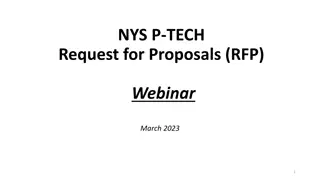
Ham Radio Technician Class Exam Preparation Power Point Overview
This presentation, instructed by Rich Bugarin W6EC, provides valuable study hints and practical insights for preparing for the Ham Radio Technician Class exam. It covers subelements, practical circuits, station equipment, and essential terminology. The content emphasizes effective study strategies and key information to help candidates succeed in the exam. Rich's additions and changes enhance the learning experience and focus on maximizing correct responses. Get ready to boost your knowledge and readiness for the upcoming exam!
Download Presentation

Please find below an Image/Link to download the presentation.
The content on the website is provided AS IS for your information and personal use only. It may not be sold, licensed, or shared on other websites without obtaining consent from the author. If you encounter any issues during the download, it is possible that the publisher has removed the file from their server.
You are allowed to download the files provided on this website for personal or commercial use, subject to the condition that they are used lawfully. All files are the property of their respective owners.
The content on the website is provided AS IS for your information and personal use only. It may not be sold, licensed, or shared on other websites without obtaining consent from the author.
E N D
Presentation Transcript
Hi-Landers Ham Class Instructed by Rich Bugarin W6EC
Ham Radio Technician Class Exam preparation Power Point created by Rich Bugarin W6EC. Effective July 1, 2022 and is valid until June 30, 2026. Please send suggested changes to this presentation to: w6ec@thebugarins.com
Study Hints I suggest you read each question and only the correct answer. Read through the complete question pool at least three times before you attempt taking a practice exams. For higher impact and better results read the correct answer first then the question and again the correct answer. The key to passing the exam is to get the most questions correct using the above method the correct response will often jump out at you on test day even if you don t remember the question.
Text Color Black: Original/Official questions and information in original format (unaltered). Red: Original information text color simply changed to highlight subject. Blue: Notes and information added by Rich (W6EC).
SUBELEMENT T7 PRACTICAL CIRCUITS [4 Exam Questions - 4 Groups]
T7A Station equipment: receivers, transceivers, transmitter amplifiers, receive amplifiers, transverters; Basic radio circuit concepts and terminology: sensitivity, selectivity, mixers, oscillators, PTT, modulation #23 of 35
T7A01 Which term describes the ability of a receiver to detect the presence of a signal? A. Linearity B. Sensitivity C. Selectivity D. Total Harmonic Distortion
T7A01 Which term describes the ability of a receiver to detect the presence of a signal? A. Linearity B. Sensitivity C. Selectivity D. Total Harmonic Distortion
T7A02 What is a transceiver? A. A device that combines a receiver and transmitter B. A device for matching feed line impedance to 50 ohms C. A device for automatically sending and decoding Morse code D. A device for converting receiver and transmitter frequencies to another band
T7A02 What is a transceiver? A. A device that combines a receiver and transmitter B. A device for matching feed line impedance to 50 ohms C. A device for automatically sending and decoding Morse code D. A device for converting receiver and transmitter frequencies to another band
T7A03 Which of the following is used to convert a signal from one frequency to another? A. Phase splitter B. Mixer C. Inverter D. Amplifier
T7A03 Which of the following is used to convert a signal from one frequency to another? A. Phase splitter B. Mixer C. Inverter D. Amplifier INTERMEDIATE FREQUENCY AMPLIFIER AUDIO AMPLIFIER 1 MIXER BEAT OSCILLATOR FREQUENCY OSCILLATOR Figure T6
T7A04 Which term describes the ability of a receiver to discriminate between multiple signals? A. Discrimination ratio B. Sensitivity C. Selectivity D. Harmonic distortion
T7A04 Which term describes the ability of a receiver to discriminate between multiple signals? A. Discrimination ratio B. Sensitivity C. Selectivity D. Harmonic distortion
T7A05 What is the name of a circuit that generates a signal at a specific frequency? A. Reactance modulator B. Phase modulator C. Low-pass filter D. Oscillator
T7A05 What is the name of a circuit that generates a signal at a specific frequency? A. Reactance modulator B. Phase modulator C. Low-pass filter D. Oscillator
T7A06 What device converts the RF input and output of a transceiver to another band? A. High-pass filter B. Low-pass filter C. Transverter D. Phase converter
T7A06 What device converts the RF input and output of a transceiver to another band? A. High-pass filter B. Low-pass filter C. Transverter D. Phase converter AKA cross band repeater
T7A07 What is the function of a transceiver s PTT input? A. Input for a key used to send CW B. Switches transceiver from receive to transmit when grounded C. Provides a transmit tuning tone when grounded D. Input for a preamplifier tuning tone
T7A07 What is the function of a transceiver s PTT input? A. Input for a key used to send CW B. Switches transceiver from receive to transmit when grounded C. Provides a transmit tuning tone when grounded D. Input for a preamplifier tuning tone
T7A08 Which of the following describes combining speech with an RF carrier signal? A. Impedance matching B. Oscillation C. Modulation D. Low-pass filtering
T7A08 Which of the following describes combining speech with an RF carrier signal? A. Impedance matching B. Oscillation C. Modulation D. Low-pass filtering
T7A09 What is the function of the SSB/CW-FM switch on a VHF power amplifier? A. Change the mode of the transmitted signal B. Set the amplifier for proper operation in the selected mode C. Change the frequency range of the amplifier to operate in the proper segment of the band D. Reduce the received signal noise
T7A09 What is the function of the SSB/CW-FM switch on a VHF power amplifier? A. Change the mode of the transmitted signal B. Set the amplifier for proper operation in the selected mode C. Change the frequency range of the amplifier to operate in the proper segment of the band D. Reduce the received signal noise
T7A10 What device increases the transmitted output power from a transceiver? A. A voltage divider B. An RF power amplifier C. An impedance network D. All these choices are correct
T7A10 What device increases the transmitted output power from a transceiver? A. A voltage divider B. An RF power amplifier C. An impedance network D. All these choices are correct CB radio calls a power amp a linier amplifier
T7A11 Where is an RF preamplifier installed? A. Between the antenna and receiver B. At the output of the transmitter power amplifier C. Between the transmitter and the antenna tuner D. At the output of the receiver audio amplifier
T7A11 Where is an RF preamplifier installed? A. Between the antenna and receiver B. At the output of the transmitter power amplifier C. Between the transmitter and the antenna tuner D. At the output of the receiver audio amplifier
T7B Symptoms, causes, and cures of common transmitter and receiver problems: overload and overdrive, distortion, interference and consumer electronics, RF feedback #24 of 35
T7B01 What can you do if you are told your FM handheld or mobile transceiver is over- deviating? A. Talk louder into the microphone B. Let the transceiver cool off C. Change to a higher power level D. Talk farther away from the microphone
T7B01 What can you do if you are told your FM handheld or mobile transceiver is over- deviating? A. Talk louder into the microphone B. Let the transceiver cool off C. Change to a higher power level D. Talk farther away from the microphone
T7B02 What would cause a broadcast AM or FM radio to receive an amateur radio transmission unintentionally? A. The receiver is unable to reject strong signals outside the AM or FM band B. The microphone gain of the transmitter is turned up too high C. The audio amplifier of the transmitter is overloaded D. The deviation of an FM transmitter is set too low
T7B02 What would cause a broadcast AM or FM radio to receive an amateur radio transmission unintentionally? A. The receiver is unable to reject strong signals outside the AM or FM band B. The microphone gain of the transmitter is turned up too high C. The audio amplifier of the transmitter is overloaded D. The deviation of an FM transmitter is set too low
T7B03 Which of the following can cause radio frequency interference? A. Fundamental overload B. Harmonics C. Spurious emissions D. All these choices are correct
T7B03 Which of the following can cause radio frequency interference? A. Fundamental overload B. Harmonics C. Spurious emissions D. All these choices are correct
T7B04 Which of the following could you use to cure distorted audio caused by RF current on the shield of a microphone cable? A. Band-pass filter B. Low-pass filter C. Preamplifier D. Ferrite choke
T7B04 Which of the following could you use to cure distorted audio caused by RF current on the shield of a microphone cable? A. Band-pass filter B. Low-pass filter C. Preamplifier D. Ferrite choke
T7B05 How can fundamental overload of a non-amateur radio or TV receiver by an amateur signal be reduced or eliminated? A. Block the amateur signal with a filter at the antenna input of the affected receiver B. Block the interfering signal with a filter on the amateur transmitter C. Switch the transmitter from FM to SSB D. Switch the transmitter to a narrow-band mode
T7B05 How can fundamental overload of a non-amateur radio or TV receiver by an amateur signal be reduced or eliminated? A. Block the amateur signal with a filter at the antenna input of the affected receiver B. Block the interfering signal with a filter on the amateur transmitter C. Switch the transmitter from FM to SSB D. Switch the transmitter to a narrow-band mode
T7B06 Which of the following actions should you take if a neighbor tells you that your station s transmissions are interfering with their radio or TV reception? A. Make sure that your station is functioning properly and that it does not cause interference to your own radio or television when it is tuned to the same channel B. Immediately turn off your transmitter and contact the nearest FCC office for assistance C. Install a harmonic doubler on the output of your transmitter and tune it until the interference is eliminated D. All these choices are correct
T7B06 Which of the following actions should you take if a neighbor tells you that your station s transmissions are interfering with their radio or TV reception? A. Make sure that your station is functioning properly and that it does not cause interference to your own radio or television when it is tuned to the same channel B. Immediately turn off your transmitter and contact the nearest FCC office for assistance C. Install a harmonic doubler on the output of your transmitter and tune it until the interference is eliminated D. All these choices are correct
T7B07 Which of the following can reduce overload of a VHF transceiver by a nearby commercial FM station? A. Installing an RF preamplifier B. Using double-shielded coaxial cable C. Installing bypass capacitors on the microphone cable D. Installing a band-reject filter
T7B07 Which of the following can reduce overload of a VHF transceiver by a nearby commercial FM station? A. Installing an RF preamplifier B. Using double-shielded coaxial cable C. Installing bypass capacitors on the microphone cable D. Installing a band-reject filter
T7B08 What should you do if something in a neighbor s home is causing harmful interference to your amateur station? A. Work with your neighbor to identify the offending device B. Politely inform your neighbor that FCC rules prohibit the use of devices that cause interference C. Make sure your station meets the standards of good amateur practice D. All these choices are correct
T7B08 What should you do if something in a neighbor s home is causing harmful interference to your amateur station? A. Work with your neighbor to identify the offending device B. Politely inform your neighbor that FCC rules prohibit the use of devices that cause interference C. Make sure your station meets the standards of good amateur practice D. All these choices are correct
T7B09 What should be the first step to resolve non- fiber optic cable TV interference caused by your amateur radio transmission? A. Add a low-pass filter to the TV antenna input B. Add a high-pass filter to the TV antenna input C. Add a preamplifier to the TV antenna input D. Be sure all TV feed line coaxial connectors are installed properly
T7B09 What should be the first step to resolve non- fiber optic cable TV interference caused by your amateur radio transmission? A. Add a low-pass filter to the TV antenna input B. Add a high-pass filter to the TV antenna input C. Add a preamplifier to the TV antenna input D. Be sure all TV feed line coaxial connectors are installed properly
T7B10 What might be a problem if you receive a report that your audio signal through an FM repeater is distorted or unintelligible? A. Your transmitter is slightly off frequency B. Your batteries are running low C. You are in a bad location D. All these choices are correct
T7B10 What might be a problem if you receive a report that your audio signal through an FM repeater is distorted or unintelligible? A. Your transmitter is slightly off frequency B. Your batteries are running low C. You are in a bad location D. All these choices are correct






















